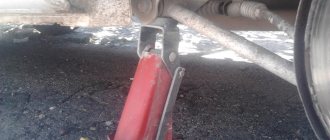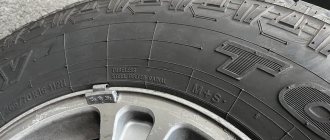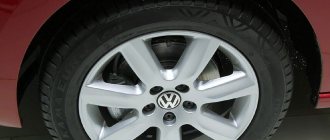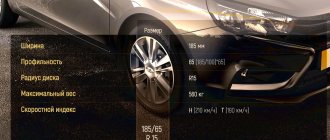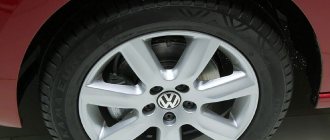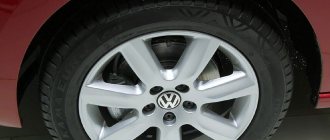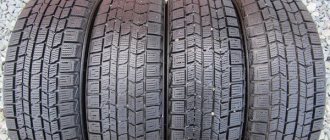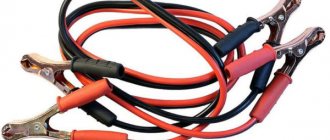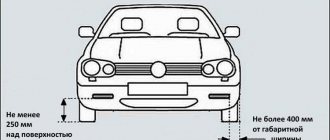The modern tire industry is creating its products better and better. Universal products are able to feel great on dry asphalt, drain water, provide traction, and in addition, provide acoustic comfort and reduce fuel consumption.
For modern cars, many sets are offered with a variety of treads and mixture compositions. This versatility has one drawback. The tread pattern differs between the halves of the tire. Therefore, there are Rotation, Inside or Outside marks on the tires, indicating the correct direction of rotation.
In this article we will talk about marking the direction of tire rotation, types of rubber, directional and non-directional tread patterns, and also tell you about all the pros and cons of such products.
What is rotation on tires
The main factor to pay attention to is the tire tread. A well-chosen pattern will maximize the contact patch with the road and help drain water and slush, preventing rubbing. Wheels come in both directional and non-directional patterns or asymmetrical structure. They differ in technical characteristics, production costs and recommended conditions of use.
A set with a symmetrical non-directional tread is considered universal. In addition, the technological process for producing such tires is much simpler than special tires, which has a positive effect on the price. In addition, it is easy to install tires with such a tread, because it is impossible to mix up the seats.
However, this pattern does not provide maximum tire-road contact in adverse weather conditions. This solution is a compromise. It is better to use universal tires as a spare tire , which can easily fit in any place, but not as an everyday option. Directional tires have their own pattern, which allows them to more effectively drain water and resist hydroplaning. The performance compared to a tire with a non-directional pattern is much higher. However, if they are installed incorrectly, the tread grooves will, on the contrary, draw in drops. Therefore, it is important to install such tires correctly.
These wheels have their own designation in the form of the Latin word Rotation. The direction of movement is indicated by the corresponding arrow. The disadvantage of such tires is that the wheels can only be placed on a certain side without removing them from the rim due to the fact that the tread pattern varies. If you want to put the left wheel on the right side, you need to remove the tires.
How to properly install a tire with an asymmetric tread pattern?
First of all, you need to understand that this is an asymmetric tire. Often the asymmetry is mild, and the owner can install the tire without looking, like a regular symmetrical model, which can be installed on either side. Always pay attention to the markings of the sidewalls - it can tell a lot not only about which side to put it on (inside and outside), but also what conditions the tires are suitable for, reveal the release date, size, etc. If you haven’t read our article, where we examined in detail each symbol on the side of the tire, we recommend that you read it.
You should absolutely not install tires on a whim - it seems that if the drainage grooves point in the right direction, then that’s how it should be. You don't know exactly what drainage and traction technology the creators used, or how they planned to install the tire. There will be no problems if you install according to the Inside marking - the side of the wheel is pressed against the car body, Outside - faces the street. Left – install the tire on the left of the car, Right – on the right. The arrow points strictly in the direction of movement.
What does Outside mean on tires?
Asymmetrical and directional tires are considered the most expensive and high-tech kits installed on cars.
Such tires are capable of providing a maximum contact patch between the tire and the road, a high level of grip, and a confident response to steering turns. Such characteristics are ensured by different patterns on the inside and outside of the tire, where one part has a “rain” tread, and the second has a “dry” tread. The outer segment of the treadmill has greater rigidity and, during fast turns, guarantees excellent grip on the road surface and stable movement of the car.
Inner segments typically have smaller blocks and have improved performance in rain, allowing water to be effectively directed away from the tread. Conventionally, such wheels can be divided into left and right, because they have different inner and outer sides of the tire and are not interchangeable.
The outside marking tells us about the outside of the wheel. This designation helps when installing tires with your own hands. A similar inscription can be found on the side of the wheel, next to the size indicators.
Inside value on tires
Sometimes tires are labeled Inside.
Everything is simple here - this is a designation for the inner side of a tire with an asymmetrical pattern. Such marks facilitate the installation of asymmetrical wheels, because they must be installed according to strict regulations. Otherwise, the kit will not provide adequate traction. There are wheels that have both directional and asymmetrical patterns, which have earned the best reviews. Such sets allow you to effectively cling to the asphalt and provide maximum traction in a situation when the rest of the tires are already giving up. The only drawback of such tires is their high cost. The price of tires from the same manufacturer will be 10-15% higher. A special calculator will help you calculate the cost of a suitable kit.
How to find out the direction of the tires?
Recognizing rubber with a directional pattern is quite simple. On the sidewall there may be an arrow and the inscription Rotation, indicating the movement of the car forward. If there is no such marking, then we have a non-directional tread and the direction of the tire does not matter.
You can also visually determine the direction of rotation of the tire. For effective drainage of water from the tread, the guides should go from the center of the disc to its edges. If the pattern matches, then the wheels are installed correctly. If not, then perhaps this direction of rotation is incorrect and you should pay attention to this by checking with the marks on the side of the wheel.
Kits often contain additional symbols that provide useful information. For example, you can see twi marks on a tire; these are indicators that indicate the degree of tread wear. The last mark is at the minimum permissible height of 1.6 mm. Marks like these help you understand which tires need replacing and keep track of your tires.
Questions often ask about what M+S means. M+S marks are primarily placed on all-season tires. The literal designation is Mud+Snow, that is, the ability to work effectively on mud or snow. However, it is worth remembering that there is no universal solution and it is impossible to fit the best ones into one set of tires.
All-season wheels work best at near-zero temperatures, so in fact such wheels are demi-season. If the thermometer fluctuates significantly in any direction, the tire performance deteriorates significantly compared to the installed seasonal sets. Therefore, it is advisable to have summer and winter tires.
Acceleration
A clear sign of clutch wear is when the vehicle accelerates. If the car does not accelerate in proportion to pressing the throttle, that is, the engine begins to oil, but the car does not move, especially uphill, then this is exactly one of the following reasons:
- The clutch drive is poorly adjusted (the cable is too tight or the hydraulic cylinder rod is too protruded, depending on the type of drive)
- Clutch disc wear
- Oil got on the clutch
- Someone pushed hard from the start and burned the disk. One start is enough to get a good burn.
So, the clutch drive is tightened for a reason, mainly when the basket is already tired and does not work within factory limits, that is, it has lost a little rigidity and in order for it to move away from the disc when pressed, you have to press deeper on it. Definitely a replacement. Another reason may be a cable with less rigidity than necessary; it stretches more than it should and does not press much. In order for it to work at least somehow, it has to be clamped more than required. We need to check, otherwise the basket will turn out to be working, I had this happen.
When the friction linings of the clutch disc wear out, the friction between the basket and the flywheel disappears. The same thing happens when oil gets on the disk - a common situation when the rear oil seal of the engine leaks. Here you need to remove the box and change the oil seal, because it won’t work like that. At the same time, you can change the disk, you can leave the basket, and look at the situation.
Worn “slightly burnt” clutch
But the clutch disc also becomes unusable if you press too hard at the start (street racers, hello!), the disc burns out immediately and loses its frictional properties, with the bonus of a burnt smell.
In general, if it smells burnt when driving, then this clutch stinks, especially when it is not pressed in enough and the disc is rubbing.
Inner and outer side of the tire
Markings on the outside or inside of the tire are extremely important in order to install the tires correctly. Therefore, let us briefly summarize the material presented above:
- The most universal is non-directional symmetrical rubber, which can be placed in any place without removing it from the disk; directional - no. Therefore, it is worth having a spare tire with such a tread - this will make the situation easier when necessary;
- outside markings, like inside marks on tires (translation: outer or inner side), indicate an asymmetrical tread pattern. The inscriptions are printed on the sides of the product. These wheels have two different tire sections for dry or wet pavement;
- asymmetrical rubber provides more confident grip on the road, excellent water drainage, and a maximum contact patch. However, such tires cannot be swapped relative to the left or right side of the car;
- the cost of such sets is 10-15% higher than similar tires with a standard pattern;
- When installing asymmetrical sets or tires with a directional pattern, the tread pattern and the direction of wheel movement should be taken into account. You can learn more about all the tricks of tire fitting from professional videos.
Advice.
If you encounter difficulties in determining the direction of tire rotation, do not hesitate to consult specialists who will help you understand all the nuances and also provide more accurate information on this issue.
Approach the issue of installing tires competently and wisely, because your safety depends on it!
Source autoepoch.ru
The modern tire industry is creating its products better and better. Universal products are able to feel great on dry asphalt, drain water, provide traction, and in addition, provide acoustic comfort and reduce fuel consumption.
For modern cars, many sets are offered with a variety of treads and mixture compositions. This versatility has one drawback. The tread pattern differs between the halves of the tire. Therefore, there are Rotation, Inside or Outside marks on the tires, indicating the correct direction of rotation.
In this article we will talk about marking the direction of tire rotation, types of rubber, directional and non-directional tread patterns, and also tell you about all the pros and cons of such products.
